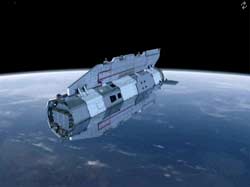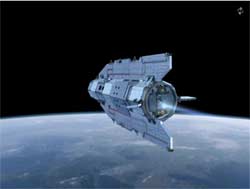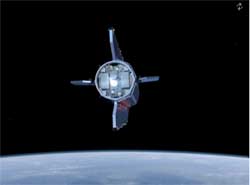ESA's GOCE satellite launch put off till Tuesday
17 Mar 2009
Moscow: The launch of the European Space Agency's (ESA) Gravity field and steady-state Ocean Circulation Explorer (GOCE) has been confirmed for Tuesday 17 March at 15:21 CET. The ESA said the problem that halted Monday's countdown had been identified and solved. The satellite will be launched by a Russian 'Rockot' rocket.
 The launch was to be carried out by Russia's Space Forces from the Plesetsk space center in northwest Russia at 5.21 p.m. Moscow time (14.21 GMT).
The launch was to be carried out by Russia's Space Forces from the Plesetsk space center in northwest Russia at 5.21 p.m. Moscow time (14.21 GMT).
The Rockot launch vehicle is a modified version of the Russian RS-18 (SS-19 Stiletto) intercontinental ballistic missile. It uses the two original lower stages of the ICBM, along with a Breeze-KM upper-stage for commercial payloads.
The Gravity field and steady-state Ocean Circulation Explorer (GOCE) satellite aims to bring about a whole new level of understanding of one of the Earth's most fundamental forces of nature – the gravity field, says ESA.
Dubbed the 'Formula 1' of spacecrafts, this sleek, high-tech gravity satellite embodies many firsts in terms of its design and use of new technology in space to map Earth's gravity field in unprecedented detail, says an ESA statement.
As the most advanced gravity space mission to date, ESA says, GOCE will realise a broad range of fascinating new possibilities for the fields of oceanography, solid Earth physics, geodesy and sea-level research, and significantly contribute to furthering our understanding of climate change.
It is often assumed that the force of gravity on the surface of the Earth has a constant value, but in fact the value of 'g' varies subtly from place to place. These variations are due to a number of factors such as the rotation of the Earth, the position of mountains and ocean trenches and variations in density of the Earth's interior.
 Over its lifetime of about 20 months, GOCE will map these global variations in the gravity field with extreme detail and accuracy. This will result in a unique model of the geoid, which is the surface of equal gravitational potential defined by the gravity field – crucial for deriving accurate measurements of ocean circulation and sea-level change, both of which are affected by climate change.
Over its lifetime of about 20 months, GOCE will map these global variations in the gravity field with extreme detail and accuracy. This will result in a unique model of the geoid, which is the surface of equal gravitational potential defined by the gravity field – crucial for deriving accurate measurements of ocean circulation and sea-level change, both of which are affected by climate change.
The 'arrow-like', five-metre long GOCE satellite will orbit just 250 km above the surface of the planet.
 Mission objectives:
Mission objectives:
to determine gravity-field anomalies with an accuracy of 1 mGal (where 1 mGal = 10–5 ms–2).
to determine the geoid with an accuracy of 1-2 cm.
to achieve the above at a spatial resolution better than100 km.






























